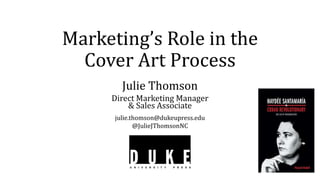AAUP 2015: Marketing's Role in the Cover Art Process (J. Thomson)
Does It Have to Be Blue? The Purpose and Evolution of Book Covers in University Press Publishing Chair: Rob Ehle, Art Director, Stanford University Press Panelists: Tom Eykemans, Senior Designer, University of Washington Press; Julie Thomson, Direct Marketing Manager & Sales Associate, Duke University Press; Christie Henry, Editorial Director, Sciences and Social Sciences, University of Chicago Press The last two decades has seen a dramatic shift in book cover design treatment at many university presses. At one time, covers were treated as tasteful ornament to serious work, often as restrained as the book’s scholarly prose, rarely eliciting spirited discussion. Cover designs are now treated as serious marketing tools, with multiple designs, multiple rounds, and, occasionally, heated debate. While academic writing is no more accessible today than it was twenty years ago, and print runs are likely to be way less than half what they used to be, are we deluded to care so much about book covers? Or are first impressions even more critical for those very reasons? Two designers, a sales manager, and an acquiring editor discuss the phenomenon, doing their best not to come to blows.

Recomendados
Mais conteúdo relacionado
Semelhante a AAUP 2015: Marketing's Role in the Cover Art Process (J. Thomson)
Semelhante a AAUP 2015: Marketing's Role in the Cover Art Process (J. Thomson) (20)
Mais de Association of University Presses
Mais de Association of University Presses (20)
Último
Último (20)
AAUP 2015: Marketing's Role in the Cover Art Process (J. Thomson)
- 1. Marketing’s Role in the Cover Art Process Julie Thomson Direct Marketing Manager & Sales Associate julie.thomson@dukeupress.edu @JulieJThomsonNC
- 2. Overview • Typically publish 60 books a season • Fall of 2012: 38 covers for the catalog • Since then we’ve had 30-40 covers in our catalogs • Fall 10: 3 covers, all front of the catalog and trade • Full-time designers: 3 (with some freelancers) • Marketing department: 9
- 3. The Cover Art Process at Duke University Press • Cover art tracking sheet • Review of author suggestions via the marketing questionnaire
- 5. The Cover Art Process at Duke University Press • Review author’s suggestions and in marketing we try to come up with other ideas too • Our Sales Manager and I meet before the launch meeting to review/discuss the cover art suggestions and ideas
- 7. The Cover Art Process at Duke University Press • At the launch meeting I briefly present the author’s and marketing’s cover art ideas. • General direction is decided upon at launch.
- 8. Advance Cover Art Meetings • Designer-driven idea • Happen after the launch meeting discussion • Typically 20 minutes once a week • Attended by Designers, Production Manager, Editors, Editorial Assistants, Marketing Director, Sales Manager, and me • Designers present cover art ideas and/or designs • This is where marketing weighs in about the proposed design • Allows for all of our departments to get behind a design • Overall this saves time • Collegial environment • A meeting and format that continues to evolve
- 9. DUP book designers typically design • Cover • Clear all cover rights and permissions for cover art • 2 sets of cover files: one in a paperback, and one in a Lithocase (paper over boards) • Book’s design specifications, which are sent to a typesetter • Our designers use freelance designers strategically to manage workloads. • We only have 1 series with a cover template. Our World and Latin America Readers series have a flexible cover template.
- 10. Collaborative Approach • Designer: We get input, help, and inspiration without getting bogged down in permissions. • Sales Manager: We have so much confidence in the skill of our designers they don’t naturally need our help, but because of time pressure we have to be involved. Their instincts are great. They used to figure out the right direction, but now we don’t have that mulling luxury. • Production Manager: Allows us to look at the possibilities, decide which direction to go, and saves time.
- 11. DUP Covers • Our covers are a great selling tool. We want to make sure we can have them as early as possible so that we can use them to sell the books. • Our covers are a big part of our Duke University Press brand. • A willingness to be edgy about what we’re putting on a cover.
- 13. Ways Marketing Uses Covers
- 17. Exhibits
- 18. What is a book cover for? It should: • attract attention • interest people in it • convey an accurate message about the book • sell the book
